
- Calculators
- Swot Analysis
- Pestle Analysis
- Five Forces Analysis
- Organizational Structure
- Copywriting
- Research Topics
- Student Resources

Services We Provide

Resources We Provide

Login / Register

- Put Experience into Learning: Johns Model of Reflection
- Exploring Different Types of Reflection Models with Examples
Christopher Johns in the year 1994 developed reflective writing specifically for the nursing sector at the Burford Nursing Development Unit. This model was inspired by Gibbs' and Rolfe's model and soon after its wide popularity, the application of the model got popular in other varieties of disciplines as well in which the education sector was also involved. The framework developed by Christopher Johns had a total of 5 sets of questions that further had other sets of questions for writing effective and advanced reflection. The similarity between Gibbs model and Johns model is that both models allow individuals to critically reflect on their experiences. On the other hand, the difference is that Gibbs model is way more structured and instructed while Johns’ model is more open ended.
Table of Contents
- Phases of Johns model of reflection
- Example of Johns model of reflection
The idea of Johns reflective model hit the researcher during his one research and that’s when he realized that for an effective reflection, there should be both internal and external factors included. As per the model, the internal factors of the model included an individual’s own emotions, thoughts, and ideas (Cox, 2005). On the other hand, the external factors consisted of factual occurrences of the experiences. To carry out the information, Johns prepared 5 sets of questions.
Furthermore, Johns utilized Barbara Crapper's pattern of knowing which she developed in 1978 included 4 phases of naming, aesthetics, personal, ethics, empirics and additionally johns added the fifth phase named reflexivity.
Five different phases of Johns model of reflection
Phase 1: describe the experience (aesthetics questions).
The first phase is all about describing the experience in detail on what you want to reflect upon. This is the reason questions under the category of aesthetics are mainly concerned with factual description. Questions under the category of aesthetics are mentioned below
- What, where, and when did happen? In this, we will highlight the background context of the situation. For example, the location, your role, time and the other necessary background information that will help readers understand the context of the situation.
- What was my reaction? While answering this, you will highlight your reaction to the occurrence of the incident you are reflecting upon.
- What was the reaction of others involved in the situation? In this, you will focus on the reaction of other people involved in the situation.
- What actions did I take? At this stage, you will state the actions taken by you when the incident occurred.
- What was the result? Lastly, you will highlight the result of your actions and the ways in which it impacted on the whole situation.
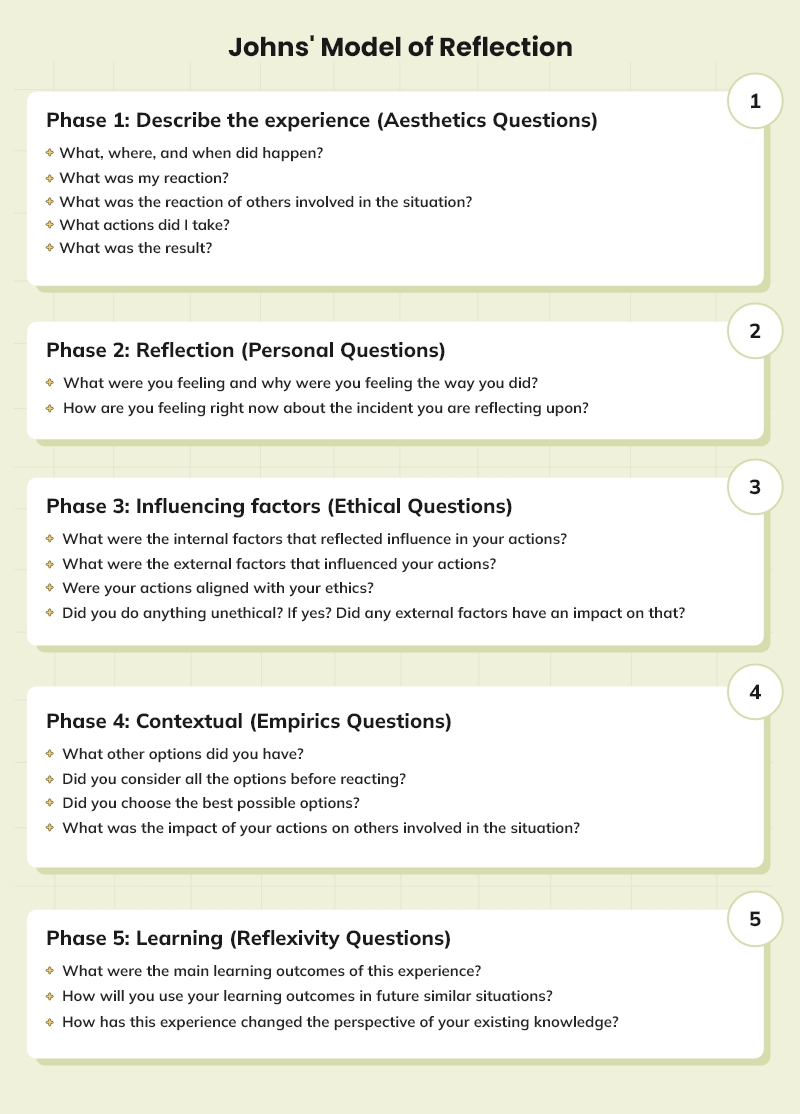
Phase 2: Reflection (Personal Questions)
The second phase is for self-reflection and all the questions asked in this phase were personal and related to the feelings oneself. This section is all about connecting the dots of factual and situational contact with feelings and how the emotional aspect contributed to the situation you are reflecting on. Some assisting questions that lie under the category of personal questions are
- What were you feeling and why were you feeling the way you did? In this, you will highlight the ways in which you felt during the occurrence of the event you are reflecting on and the major reasons behind those feelings.
- How are you feeling right now about the incident you are reflecting upon? In this, you will highlight your current feelings about the incident you are writing the reflection about.
Phase 3: Influencing factors (Ethical Questions)
In this section, you will minutely express how the internal and external factors impacted the way you acted in certain situations you are reflecting on. Moreover, you will also relate to this section with your values and ethics to support or oppose your actions. Some assisting questions that might help you with the same area -
- What were the internal factors that reflected influence in your actions? Here you will highlight the internal factors such as your feelings, thoughts or assumptions about the situation that might have influenced your actions in one way or another.
- What were the external factors that influenced your actions? While answering this, you will shed light on the various external factors such as other people’s opinion, actions, or body movements that might have impacted your actions in different ways.
- Were your actions aligned with your ethics? In this, you will highlight the fact that whether your actions were aligned with your action in any way or not.
- Did you do anything unethical? If yes? Did any external factors have an impact on that? In this, you will focus on explaining the relationship between your actions and general ethics. If the answer is yes, you will highlight if the external factors had any impact on your unethical actions.
Phase 4: Contextual (Empirics Questions)
Moving ahead, this section contains where you will explain the other alternative actions that you could have taken instead of what you did in reality. Alongside this, you will also discuss the impact of your actions on yourself or on other elements or people that were involved in the situation you are reflecting upon. Some empirical questions that will help you in the reflective writing of this section are
- What other options did you have? In this question, you will focus on exploring all the alternatives that you could have opted for in terms of acting in the situation you are reflecting on.
- Did you consider all the options before reacting? In this, you will highlight the fact that you considered options before reacting or not.
- Did you choose the best possible options? In this, you will underline the fact that whether you chose the best option of all or you had a better alternative but did not choose because of some reason.
- What was the impact of your actions on others involved in the situation? While answering this, you will highlight the impact of the actions you took on the other people that were involved in the situation.
Phase 5: Learning (Reflexivity Questions)
In the additional questions, Johns added some reflective questions that will assist you in effectively underlining the learning model. So, in this section, you will briefly describe all your learning from this experience and how you will use those learnings in the future if similar situations occur. For this, Johns underlined some assisting reflexivity questions that will assist you in writing your reflective process using the model.
- What were the main learning outcomes of this experience? In this, you will highlight the different learning outcomes you got from this learning experience.
- How will you use your learning outcomes in future similar situations? Here you will outline the ways in which you will utilize your learning outcomes from this situation to the future similar situations.
- How has this experience changed the perspective of your existing knowledge? In this, you will highlight the ways in which you got additional knowledge
Moving forward, after meticulously reviewing the model, below is Johns reflective model example in nursing that will assist you in understanding the model more comprehensively.
Johns reflective model example in nursing
Case assessment - This reflective example will focus on highlighting a nurse’s experience working at a residential care center. This reflection will highlight her experience of dealing with a patient named Mary Lou suffering from paralysis due to a damaged spinal cord.
I have been working with the residential care center for over months and this time I was placed at the house of 32-year-old Mary Lou who was paralyzed due to a damaged spinal cord that was caused by an accident in 2020. We both tuned in well until one day I experienced that Mary Lou was shivering. I instantly panicked and thought that I made some mistake that caused a temperature rise in Mary Lou's body. Mary Lou was also feeling feverish but she said her body cannot feel anything below the level of injury. Listening to this, I became a little more anxious than I was. However, I remember that during my placement I was reading a book called, “Nursing Spinal Cord Injuries”. I read that automatic regulation of temperature occurs but it only occurs at a level of injury because the connection between brain cells gets disrupted below the level of injury. In order to obtain a stable bodily self, the brain generates moment-to-moment representations by integrating and weighting different sensory inputs according to their reliability and presumably integrating them into offline body representations (Lenggenhager, Pazzaglia, Scivoletto, Molinari & Aglioti, 2012). As soon as I remembered that, I calmed myself down and gave paracetamol to Mary Lou. Soon after Mary Lou was perfectly fine.
As soon I realized that her body temperature was rising but it was only happening above the level of injury, I panicked and felt nervous. I felt this way because earlier that day, although Mary Lou was not allowed to, we had ice cream together and I thought that due to that something went wrong and she was experiencing this. I now feel that I shouldn't have just assumed things and should have thought about it thoroughly before reacting to the situation anxiously.
If I look back at the situation, I feel that Mary Lou getting tense was one major external factor that impacted my behavior or feelings in a certain way. Besides, I also feel that I shouldn't have just assumed that it happened because of my carelessness and this internal factor made me anxious in the first place. Moreover, I know that my actions are directly linked to my ethics which I did not adhere to. I feel that my action of feeding Mary Lou was completely unethical because I was not allowed to do so but I felt doing so Mary Lou’s connection formed in such a short time. This was a major external factor that led me to my unethical action as I could not say no to Mary Lou.
Elaborating contextually, other than what I did, I could have chosen not to give the ice cream to Mary Lou which was the ethical and right thing to do. Even when I was giving her the ice cream, I knew it was not the wise and best thing to do but I did it anyway. The impact of my decision led to trouble for both of us.
Through this whole experience, I learned that it is never good to react to a situation based on assumptions before knowing the reality. Besides, it is essential to use your existing knowledge and take help if necessary to keep you and the patient calm during the situation of crisis. If a similar situation occurs again, I will ensure that I take deep breaths and calm myself down before getting to a conclusion.
What are some of the limitations of Johns model of reflection?
Johns reflective model has a number of drawbacks. Complex issues may be oversimplified by its linear approach, and some people may object to the strong emphasis on feelings. Due to its structure, the model might not be able to effectively explore complexities or deal with emotionally charged situations. Furthermore, there is no clear framework for incorporating follow-up actions based on the reflection. As a result, some people could consider it less appropriate for particular reflective settings and instead favour more thorough and flexible models.
What is the difference between Johns' and Gibbs' model of reflection?
The Gibbs model of reflection has 6 stages to reflect on previous experiences whereas there are 5 stages in Johns' model of reflection. The difference lies in the last stage where Johns' model of reflection is focused on reflection and grasping the knowledge. On the other hand, Gibbs' model of reflection also places emphasis on creating an action plan for the future as well.
Previous Model
Lenggenhager, B., Pazzaglia, M., Scivoletto, G., Molinari, M., & Aglioti, S. (2012). The Sense of the Body in Individuals with Spinal Cord Injury. Plos ONE, 7(11), e50757. doi: 10.1371/journal.pone.0050757
Cox, E. (2005) “Adult learners learning from experience: Using a reflective practice model to support work‐based learning,” Reflective Practice, 6(4), pp. 459–472. Available at: https://doi.org/10.1080/14623940500300517 .
Copyright © 2023 CrowJack. All Rights Reserved
- Memberships
Johns Model of Reflection explained

Johns Model of Reflection: this article provides a practical explanation of Johns Model of Reflection . This article contains the definition of Johns Model of Reflection, an example in healthcare and a step-by-step plan to start yourself. After reading this article, you’ll understand the basics of this experiential learning and reflective practice tool. Enjoy reading!
What is Johns Model of Reflection?
The Johns Model of Reflection (MSR) is a model for structured reflection by Christopher Johns. The model was originally developed for the nursing sector at the Burford Nursing Development Unit, in the early nineties.
However, the Johns Model of Reflection was soon adopted in several other sectors as well. He viewed this model as an essential part of the process of structured reflection.

The model was inspired by the research Johns conducted in which he observed the dialogue between practitioners of a profession and their supervisors. The model can help to reflect on and analyse complex decision making but can also be useful in learning to critically reflect.
He focused on discovering knowledge that is used in practice and to make this explicit. The framework that Johns developed consists of five cue questions that are subsequently divided into more detailed questions to advance reflection.
Johns suggested that one should have an internal and external focus while thinking. An internal focus refers to one’s own emotions and thoughts, and an external focus means to consider the factual situation or incidents. This is done by answering the cue questions that belong to each phase.
What is critical reflection?
Critical reflection enables people to synthesise different perspectives (or ideas, opinions, etc.) to help explain what we encounter in everyday life. It’s possible that a theory or literature offers a perspective that must be considered, can provide proof to support ideas or challenge these explicitly.
Additionally, critical reflection posits that people are able to analyse what was learnt and how this was learnt. This learning style is essential to gain control over one’s own development.
For the above-mentioned reasons, critical reflection is deemed to be of great importance, particularly in the professional development of teachers: they ready youngsters for their professional careers.
What is a critical analysis?
To profit from the use of the Johns model of reflection as much as possible, it’s important to understand what critical analysis entails. A critical analysis concerns both critical thinking and conducting the analysis.
An analysis is the process in which a complex subject or problem is divided into smaller parts to get a clearer view. An example of this is investigating the reasons why students fail to understand certain concepts.
A non-analytical approach could show that the students simply weren’t ready to learn about such a complex subject. A more critical analytical approach, however, could demonstrate that there are several factors that influence the students’ inability to understand the subject.
Examples of such reasons include:
- The context of the lesson wasn’t clear
- The way the teacher evaluates the students’ understanding
Critical thinking is in fact a skeptical or inquiring approach to knowledge. Someone who often thinks critically will doubt assumptions and look at a problem from different perspectives.
Critical analysis is mostly concerned with setting aside personal opinions and values when considering information or ideas. Subsequently, evidence to define the investigated problem must be sought.
Phases and step-by-step plan of structured reflection of Christopher Johns
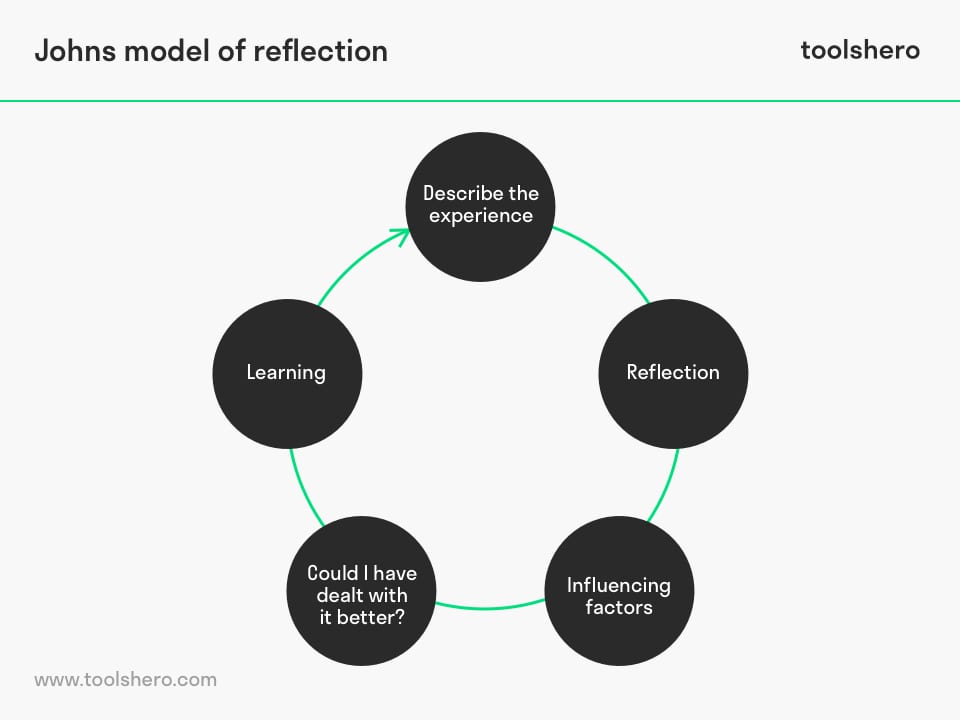
Figure 1 – Johns Model of Reflection
Phase 1: describe the experience
The first phase concerns describing the situation. This is done by answering several questions. Use the questions below to support the reflection.
Describe the experience you’re feeling and living right now.
What essential factors contributed to this experience?
What significant background factors belong to this experience?
What are the key processes for reflection during this experience?
Phase 2: reflection
The second phase is about the reflection itself. Answer the following questions:
- What am I trying to achieve?
- Why did I approach this the way I did?
- What were the consequences of my actions for me?
- What were the consequences of my actions for the patient? My family?
- What were the consequences of my actions for the people I work with?
- How did I feel during this experience?
- How did others feel during this experience?
- How do I know how others felt during this experience?
Phase 3: influencing factors
The third phase revolves around the factors that influenced the situation as it occurred. Answer the following questions as part of Johns’ model of reflection:
- What internal factors influenced my decision making during the experience?
- What external factors influenced my decision making during this experience?
- What sources of knowledge were available?
- What sources could I have consulted?
- What sources and information would have impacted my choice?
Phase 4: what could I have done better
The fourth phase concerns identifying improvement areas for the situation as it occurred. Answer the following questions:
- What other options did I have?
- What consequences are involved in the other options?
- Have I considered all options?
- Have I selected the best option?
Phase 5: learning
The fifth phase is about learning from areas for improvement as identified in the previous phase. Answer the following questions:
- What will change because of this experience?
- How do I feel about my experience now?
- Does this situation have to do with past situations?
- What would have been a better way to approach this situation?
- What are the consequences of alternatives choices I’ve made for patients? For others and for me?
- How approachable and available am I to better help my patients and colleagues?
- Empirical – scientific
- Ethical – moral knowledge
- Personal – self-awareness
- Aesthetic – the art of what we do, our own experiences
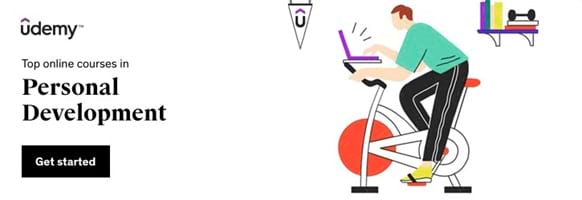
Johns Model of Reflection example in healthcare
It’s not surprising that Johns Model of Reflection arose in the nursing profession. In frontlines such as hospitals and nursing homes, nurses fulfil a crucial role in seeing to the needs concerning patients’ physical and mental wellbeing. In these institutions, reflective working is very important for various reasons.
Scientific research by Oelofsen, Somerville and Keeling shows that reflective practices at work advance the development of skills such as awareness and the ability to influence others. Working reflectively ensures that people gain insight into pratical events and how someone’s own approach and history has contributed to the way situations arose and how these were handled.
Translated to the physical workplace of many nurses, the Johns model of reflection can be summarised in three steps:
1. Curiosity
The process starts by noticing things, asking the right questions, and questioning assumptions. In the first step, nurses and other professionals ask the questions that help them understand the situation that must be reflected upon. Answer the following questions for this purpose:
- What really happened?
- Why was the situation handled as it was?
- What else could have happened?
- What more can happen now?
- What do I think of this situation?
- How has the situation affected me?
- What was the situation’s influence on others? The team?
2. Take a closer look
The second step is concerned with actively working on the questions from step 1. Reflective professionals do what is needed to find out more about the patient, themselves, colleagues and information. They also zoom in on their own experiences and feelings and can slow down their own thoughts and actions for further contemplation.
In this step, reflective professionals try to find ways to articulate the phenomena from step 1 and to become aware of all underlying assumptions that lie at the foundation of their own practices and actions.
3. Transformation
The third and final phase revolves around converting feedback into action. Through observations gained during the first phase in combination with the observations from step 2, the transformation phase is about finding a way to design the process in such a way that it facilitates positive change.
The goal of this phase is to take action that leads to better methods and eventually better service.
Johns Model of Reflection: aspects of reflection
As you’ve read, a critical reflective cycle is particularly important for teachers. Teaching is a complex activity during which decisions are made in complex contexts. Reflective practices are generally considered to be an important activity for professional development.
There is a great deal of literature and studies available that discuss the importance of reflection and reflective practices, i.e. the Gibbs Reflective or John Driscoll Model of Reflection . There are important characteristics of reflection that are generally supported by each of these studies.
- Reflection results in learning. This is due to changing ideas, but also a changing understanding of the situation
- Reflection is an active learning process, and is more than simply thinking
- Reflection is not a linear process, it is cyclical, where reflection leads to the development of new ideas or opinions that are used to plan the next learning phases
- Reflection encourages one to view problems from as many perspectives as possible. This helps to properly understand the issue and to investigate personal values, assumptions and ideas.
Therefore, critical reflection refers to a combination of analytical, inquisitive or reflective approaches. A critically reflective conversation is thus characterised by a combination of these factors.
Implementing Johns Model of Reflection on the work floor
Employees of all types of companies are regularly asked to improve and demonstrate their abilities in the field of critical reflection.
This can be quite complex, particularly as little guidance is offered. Below, you can find several tools and methods that are frequently used in developing the ability for critical reflection.
- Learning sheets, blogs, studies, articles
- Written assessment tasks regarding predetermined points
- Meetings with tutor/ mentor
Regardless of the size or subject of these reflection methods, they all enable the user to reflect on a deep level.
Johns Model of Reflection: critical reflection and transformational learning
Mezirow, among others, posited that reflection only leads to learning when it generates transformation. Additionally, Mezirow suggested that transformation only takes place where the original starting point of a dilemma must be addressed. If that’s the case, several phases are completed:
- A dilemma that creates disorientation: loss of a job, divorce, going back to school, move, emigrating, a marriage that ends, etc.
- Self-investigation with feelings of anger, fear, shame or guilt
- Critical assessment of assumptions
- Acknowledging someone’s dissatisfaction
- Exploring new options for relationships, actions or roles
- Plotting a course
- Acquiring knowledge and skills for implementing new plans
- Preliminary testing of new roles
- Building competence and self-confidence in new relationships, actions and roles
- Reintegration into someone’s life based on new circumstances that are imposed by a new perspective or adopting new views

Now it’s your turn
What do you think? Do you recognise the explanation of the Johns Model of Reflection? Do you believe it’s important to reflect regularly? Do you train your critical thinking? Do you believe that reflection methods should form a fixed part of Human Resource Management? Do you have any tips or additional comments about this theory?
Share your experience and knowledge in the comments box below.
More information
- Johns, C. (1995). Framing learning through reflection within Carper’s fundamental ways of knowing in nursing . Journal of advanced nursing, 22(2), 226-234.
- Johns, C. (1996). Visualizing and realizing caring in practice through guided reflection . Journal of Advanced Nursing, 24(6), 1135-1143.
- Johns, C. (1999). Reflection as empowerment? . Nursing Inquiry, 6(4), 241-249.
- Johns, C. (2009). Guided reflection: Advancing practice . John Wiley & Sons.
- Johns, C., & Freshwater, D. (Eds.). (2009). Transforming nursing through reflective practice . John Wiley & Sons.
- Johns, C. (Ed.). (2017). Becoming a reflective practitioner . John Wiley & Sons.
How to cite this article: Janse, B. (2020). Johns Model of Reflection . Retrieved [insert date] from Toolshero: https://www.toolshero.com/personal-development/johns-model-of-reflection/
Original publication date: 03/14/2020 | Last update: 12/17/2023
Add a link to this page on your website: <a href=”https://www.toolshero.com/personal-development/johns-model-of-reflection/”>Toolshero: Johns Model of Reflection</a>
Did you find this article interesting?
Your rating is more than welcome or share this article via Social media!
Average rating 5 / 5. Vote count: 12
No votes so far! Be the first to rate this post.
We are sorry that this post was not useful for you!
Let us improve this post!
Tell us how we can improve this post?

Ben Janse is a young professional working at ToolsHero as Content Manager. He is also an International Business student at Rotterdam Business School where he focusses on analyzing and developing management models. Thanks to his theoretical and practical knowledge, he knows how to distinguish main- and side issues and to make the essence of each article clearly visible.
Related ARTICLES

Brian Tracy biography, quotes and books

Outline Method of Note Taking

Single Loop Learning by Chris Argyris and Donald Schön

Reflective Learning Approach: reflect and learn

Mezirow’s Transformative Learning Theory

What Is Coaching And Is It For You?
Also interesting.

5E Instructional Model

4MAT Learning Styles Model by Bernice McCarthy
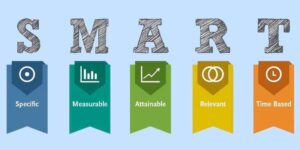
SMART Goals explained
Leave a reply cancel reply.
You must be logged in to post a comment.
BOOST YOUR SKILLS
Toolshero supports people worldwide ( 10+ million visitors from 100+ countries ) to empower themselves through an easily accessible and high-quality learning platform for personal and professional development.
By making access to scientific knowledge simple and affordable, self-development becomes attainable for everyone, including you! Join our learning platform and boost your skills with Toolshero.

POPULAR TOPICS
- Change Management
- Marketing Theories
- Problem Solving Theories
- Psychology Theories
ABOUT TOOLSHERO
- Free Toolshero e-book
- Memberships & Pricing

Johns’ Model of Reflection
This is one of a series of articles relating to reflective practice .
In this article, we are going to be taking an in-depth look at a model of reflection created by Christopher Johns- a professor of nursing- in 1994. We will be examining the model thoroughly, including the advantages and disadvantages of the model, as well as some general knowledge about its creator.
Let’s get started.
Table of Contents
About Christopher Johns
Christopher Johns is a professor of nursing who developed the Model for Structured Reflection (MSR), a practice intended to offer a comprehensive guide to reflection in the nursing profession . Originally published in the early 1990s, Johns has continually developed and revised his model over the last two decades.
The model was designed for use by students and professionals alike. It provides a framework that can be used to reflect on any aspect of nursing practice or education.
Carper’s Fundamental Patterns of Knowing in Nursing
The structure of Johns’ Model of Reflection is based on Carper’s Fundamental Patterns of Knowing in Nursing (1978). Therefore it is useful to have an understanding of Carper’s work.
Carper argues that there are four primary sources of knowledge. They are:
- Empirics – the science of nursing
- Aesthetics – the art of nursing
- Personal – personal knowledge in nursing
- Ethics – moral knowledge in nursing
She goes on to explain that these sources must be used together to provide effective nursing practice. For example, simply using empirical theoretical knowledge is not enough – nursing requires creativity from aesthetic knowledge to provide care that can achieve positive outcomes for the unique individual, as well as personal knowledge of the situation to build a bond of trust between patient and practitioner and ethical knowledge to work within the framework of what is right and moral.
Johns’ Model of Structured Reflection
Along with the four variations of knowing implemented by Carper in the Knowledge Pattern (empirical knowledge, personal knowledge, ethical knowledge, and aesthetic knowledge), Johns added another domain, which he termed reflexivity or knowledge obtained from past experience.
This formed the foundation of his Model for Structured Reflection (MSR), which is essentially a series of cue questions to support the reflective practitioner to consider all aspects of an experience and derive meaning and learning from it.
These cue questions, as written by Johns in Transforming Nursing Through Reflective Practice (2009), as well as the associated way of knowing have been provided below.
As you can see, each of the cue questions are linked to one of the fundamental ways of knowing and can be used to get a full picture of the experience before reflecting on what can be learned from it and how the experience may inform future practice.
Aesthetic questions
The aesthetic questions are concerned with what happened during the experience and what were the consequences. We might write a factual and objective description of the scenario and what we were thinking whilst it was happening.
Personal questions
The personal questions help us to consider our feelings during the experience and the influencing factors that may have contributed to these emotions.
Empirical questions
The empirical questions explore how our knowledge (or lack of knowledge) may have informed the experience. We might think about how our training, theory and academic literature played a part in the experience.
Ethical questions
The ethical questions help us to frame the experience in relation to our own personal values. We might also consider professional codes and best practices.
Reflexive questions
Finally, reflexive questions help us to get meaning from the experience and identify what we have learned from the situation. We might look at how we feel now and what we might do differently if a similar situation in the future.
Advantages and Disadvantages of Johns’ Model of Reflection
There are several pros and cons to Johns’ model of structured reflection, which we will explore below.
Advantages of Johns’ model include:
- It is very detailed and the questions help to develop a holistic viewpoint of the situation which facilitates deeper thinking
- It considers the viewpoints of others and the influence of values and ethics, which s not present in other models
- Johns has produced a lot of literature in relation to reflective practice, so it is underpinned by a lot of theory
- Johns has tested and validated his model in practice
Disadvantages
Disadvantages of Johns’ model include:
- The detail of the model and the volume of associated literature mean that the model can be quite complex and require a lot of time and effort to understand and use
- The complexity can also make the model appear to be very prescriptive and lack flexibility
- Unlike other models, Johns’ MSR does not explicitly connect our learning to the creation of an action plan
Alternatives To Johns’ Model of Reflection
Here, we will discuss alternative models of reflection that may be used to overcome some of the disadvantages of the Johns model.
The Kolb Reflective Cycle (1984)
Kolb’s reflective cycle is a lot less complex than Johns’ model because it is made up of a simple 4-step process:
- Concrete experience – the experience
- Reflective observation – reflecting on the experience
- Abstract conceptualization – new insights and perspectives gained
- Active experimentation – putting the new learning into practice
The simplicity of this model means that there is flexibility for the practitioner to cover only the areas that they deemed important to the experience, which can be useful if time is limited. The caveat is that important areas may be quickly dismissed or inadvertently omitted from the process that may result in missed learning opportunities.

The Gibbs Model of Reflection (1988)
Gibbs’ reflective cycle builds on that of Kolbs and whilst it is slightly more complex, it is still a lot simpler than Johns’ model. Both Kolb and Gibbs also emphasise the process of developing an action plan, so that the learning can be put into practice following self-reflection.
Atkins and Murphy Model of Reflection (1994)
Although Atkins and Murphy’s framework for structured reflection is still quite complex, it is slightly less so than that of Johns. It also has a lot of emphasis on self-awareness and open-mindedness that can help us to challenge our innate or longstanding prejudices that may influence our practice.
As with Johns’ model, Atkins and Murphy’s work was also developed for use in the nursing profession .
An Example of Johns’ Model of Reflection
A great practical example of using Johns’ Structured Model of Reflection is provided by Johns in his paper Framing learning through reflection within Carper’s fundamental ways of knowing in nursing .
This describes the experience of a nurse working in a corporate occupational health department when an employee refers themselves after having taken drugs. The employee gives a bag of drugs to the nurse so that they know what they have taken before becoming agitated, resulting in the nurse calling security and an ambulance. The nurse had wanted to protect the employee and said that they would not report it this time and disposed of the drugs in the bin but fished them out when the ambulance arrived having felt it was important to their wellbeing. The vice-president became away of the situation and asked the nurse what had happened. The nurse provided an honest account and the employee was fired from their job.
- The nurse’s lack of knowledge in relation to substance use and reactions to drug-taking
- Nurse did not know employee well
- Nurse disapproved of drug-taking but had empathy towards patient and so took a ‘critical mother’ approach to the interaction
- Nurse felt an element of anxiety/panic during the experience
- The dilemma between the confidentiality of the patient and the responsibility to report substance use to the employer
- Guilt following the employee losing their job
Reflexivity
- The nurse feels they should learn more about substance abuse
- The nurse feels that they behaved appropriately during the experience but still feels a sense of guilt about the employee being sacked
- The nurse considers approaching the vice-president to ask for the employee to be reinstated to help with their guilt
- The nurse recognises that they have not yet approached the vice-president through a lack of assertiveness and wanting to avoid conflict – this consequently made them feel angry and frustrated
- The nurse will use this experience to improve their practice as well as supporting other team members that may have similar experiences
- Carper, B. (1978). Fundamental Patterns of Knowing in Nursing
- Johns, C. (1995). Framing learning through reflection within Carper’s fundamental ways of knowing in nursing. Journal of advanced nursing, 22(2), 226-234
- Johns, C. (1996). Visualizing and realizing caring in practice through guided reflection. Journal of Advanced Nursing, 24(6), 1135-1143
- Johns, C. (1999). Reflection as empowerment?. Nursing Inquiry, 6(4), 241-249
- Johns, C. (2009). Guided reflection: Advancing practice. John Wiley & Sons
- Johns, C., & Freshwater, D. (Eds.). (2009). Transforming nursing through reflective practice. John Wiley & Sons
- Johns, C. (Ed.). (2017). Becoming a reflective practitioner. John Wiley & Sons.
- Entertainment
- Environment
- Information Science and Technology
- Social Issues
Home Essay Samples Information Science and Technology Class Reflection
Analysis of Johns' Model in Enhancing Professional Practice
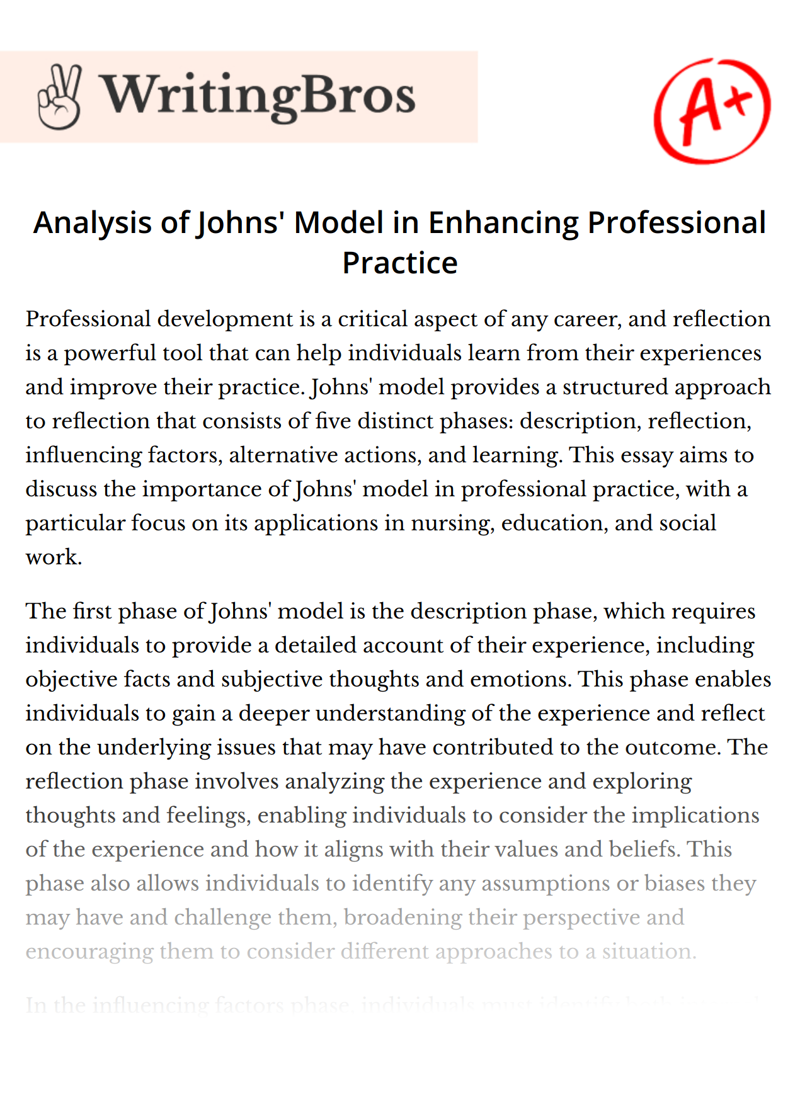
*minimum deadline
Cite this Essay
To export a reference to this article please select a referencing style below

- Operating System
- Digital Era
- Julian Assange
- Microsoft Corporation
- Children and Technology
Related Essays
Need writing help?
You can always rely on us no matter what type of paper you need
*No hidden charges
100% Unique Essays
Absolutely Confidential
Money Back Guarantee
By clicking “Send Essay”, you agree to our Terms of service and Privacy statement. We will occasionally send you account related emails
You can also get a UNIQUE essay on this or any other topic
Thank you! We’ll contact you as soon as possible.

Ben Richardson
Acuity Training
Read more from Ben Richardson
googletag.cmd.push(function() { googletag.display(‘div-gpt-ad-1705321608055-0’); });
- September 19, 2023
Applying Johns Reflection Model to your learning process
- By Ben Richardson

- Tags: Behavioural Skills , Evergreen , Learning culture , Skills
What is reflection? Gillett, Hammond and Martala say that the power lies in ‘being able to help develop an understanding of the way you learn, the subjects you are studying and to define your longer-term goals.’ It can help to promote critical thinking and problem-solving skills, both of which are key to academic success.
At its heart, reflection is simply thinking about and evaluating our experience, our perspectives, attributes, and interactions . It is about assessing what went well, what didn't, and why did those things happen. Therefore, reflection provides us with a deeper insight to conclude how to move forward.
The Johns Model of Reflection was implemented in a range of sectors and is considered an integral part of structured reflection
Johns Model of Reflection (MSR)
Johns Model of Reflection (MSR) by Christopher Johns explains the concept of reflection further. It was created in the early nineties for the nursing sector at the Burford Nursing Development Unit.
However, the Johns Model of Reflection was also implemented in a range of other sectors too and is considered an integral part of structured reflection and is based on five cue questions that include more detailed questions to advance the process of reflection.
What was the model influenced by?
Johns’ research on the dialogue between practitioners of a particular occupation and their supervisors was the main influence used in creating this approach and it offers a great way to reflect on and investigate complicated decision-making.
It proposes that there should be an internal and external focus for effective reflection. Internal focus is defined as an individual's own emotions and thoughts, whereas the external focus is on considering the factual situation or occurrences. This is carried out by answering cue questions in the following phases:
Phase one: Describe the experience
The first phase concerns describing the situation. This is done by answering the following questions:
- What was asked to do?
- What actually was achieved?
- How to go about the task?
- Why go about the task in that way?
Phase two: Reflection
The second phase is regarding reflection itself. This is done by answering the following questions:
- What was achieved?
- What consequences occurred from my actions?
- How did I feel?
- How do others feel?
- What could I have done differently?
Phase three: Influencing factors
The third phase considers the factors that influenced the situation by answering the following questions:
- What internal and external factors influenced my decisions?
- What knowledge did I have?
- What knowledge should I have had?
Phase four: Could I have dealt with it better?
The fourth phase is all about identifying areas of improvement using the following questions:
- What other options were considered?
- What other options were missed and why?
- Was my selection criteria correct?
Phase five: Learning
The last phase concerns learning from the previous phases by answering the following questions:
- What have I learned?
- What will I now change as a result?
- How will I stick to this?
Employees in companies of a range of sectors are frequently asked to improve and assess their performance using critical reflection. This can be done in several ways such as learning sheets, portfolios, written assessment tasks and meetings.
What is the best way to reflect?
The methods we each use to best reflect on our actions or experiences can be different for teams and individuals.
Reflecting as an individual
Writing things down is the best way to reflect as it forces you to be clear and concise in your thoughts and also provides a reference for the future. It also creates a higher level of thinking, which enables individuals to take more focused action.
Although not always possible, ideally individuals should discuss their ideas with someone involved in the project, this can help immensely as it provides a different viewpoint. Revisiting your notes periodically also helps reinforce learning.
A productive and successful meeting also allows for personal growth and creates opportunities for each individual to develop their interpersonal skills
Reflecting as a team
This needs to be conducted as a well-chaired meeting to ensure that everyone's opinions and thoughts are aired and discussed before the group decides on the best course of action. A productive and successful meeting also allows for personal growth and creates opportunities for each individual to develop their interpersonal skills.
For this meeting to be effective, the team needs to reach an agreement on what will be done differently next time and focus on what changes will be implemented in the future. It should not be a 'witch hunt' looking to point fingers but rather be skillfully chaired and set up to ensure it is a positive experience for all those involved.
Reflection improves culture
There is a range of ways that employees in companies of a range of sectors can improve and assess their performance using critical reflection, and ideally, it should be ingrained in the culture of any business. If not, individuals and organisations lose valuable lessons.
Interested in this topic? Read The power of reflection time.
One response.
Great overview of the Great overview of the learning method. I will take into account.

Does your workplace value toxicity over trust?

LGBTQ+ imposter syndrome: Turn ‘I am not good enough’ into ‘I am totally worthy’

Had enough of managers who are too busy to care? It’s time to build a coaching culture

Winners announced for Culture Pioneer Awards 2023
Most read this week.
- Culture , Lead
- 28th March 2024
- Joanne Lockwood

- Culture , Post
- 6th March 2024
Who needs to be involved in the learning experience?
- Jackie Clifford
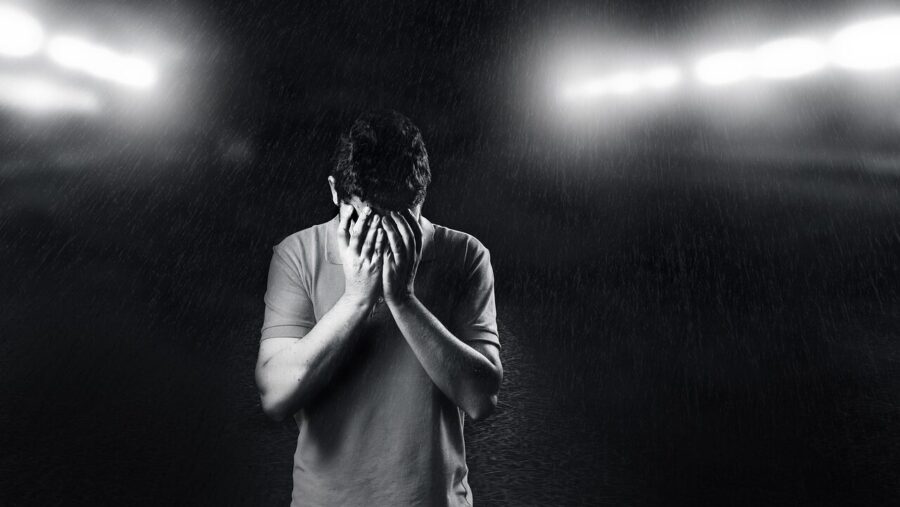
- 4th March 2024
Why leaders should always own up to their mistakes
- Thom Dennis

- Business , Develop
- 14th March 2024
A key to next-gen learning: Letting go of what’s not working
- Dani Johnson
Human-centred leadership
Leaders need to stop the self-sacrifice cycle
How to escape the relentless pace of leadership
Middle management’s biggest challenge
The role of emotional intelligence and self-compassion
Unlocking courage
We need braver leaders, so how do we get them?
- About TrainingZone
- Advertise on TrainingZone
- Terms of use
- Privacy policy
- Sub-Processors List

Get the latest from TrainingZone.
Elevate your L&D expertise by subscribing to TrainingZone’s newsletter! Get curated insights, premium reports, and event updates from industry leaders.

Want to create or adapt books like this? Learn more about how Pressbooks supports open publishing practices.
72 John Driscoll’s “What?” Cycle of Reflection
The previous chapter on reflection, “Writing About Writing: Becoming a Reflective Practitioner,” offered an introduction to reflective writing and explained how critical reflection is so important to the learning process. This chapter will look more closely at one of the most common and simplest models for how to practice the kind of reflection that fosters “reflective practitioner” attitude: John Driscoll’s cycle of reflection, which follows a “What, So What, Now What” process. The end of this chapter offers an example assignment based on the Driscoll model.
What? So What? Now What?
John Driscoll originally developed the “What?” cycle of reflection for healthcare practitioners, but it has since been picked up by many different kinds of learners. The model includes three very basic steps:
- WHAT? Describe what happened.
- SO WHAT? Analyze the event.
- NOW WHAT? Anticipate future practice, based on what you learned.
Each step requires both different rhetorical strategies and distinct forms of cognition. Step 1, “What?”, challenges the learner to recall what happened as objectively as possible, without critiquing anything that happened. Step 2, “So what?”, requires the learner to slow down and begin looking for patterns or moments of significance. Here, the key is to bring in concepts that help shed light on what’s going on. In a writing course, for example, a student might learn different rhetorical terms that relate to persuasion, such as logos , pathos , and ethos . Analyzing the experience according to anyone of those terms is a form of analysis. Finally, Step 3, “Now what?”, encourages the learner to begin transferring new knowledge to future situations and other contexts. As the introductory chapter to this section explains, transfer is key to becoming a reflective practitioner.
Here’s a video of that carefully illustrates each step, published by the McLaughlin Library at the University of Guelph:
Example of the Driscoll Cycle of reflection
The following example of the Driscoll cycle was developed by a student at The Robert Gillespie Science of Learning .
The trickiest step for those new to practicing this kind of critical reflection is moving from the straightforward objectivity of Step 1 to the more analytical kind of writing that happens in Step 2. As the commentary for Step 2, “So what?” explains, the second paragraph practices analysis by comparing current experience with an earlier one. Comparison and contrast brings in external content (the other experience) to help do the analysis. There are other ways to accomplish this cognitive move, however. As mentioned above, another strategy for analyzing content is to map experiences to key concepts or ideas picked up from the lesson material.
Sample Assignment: “ Ceasefire Reflective Essay”
The following assignment was developed for English 101: Writing and Rhetoric I at the College of Western Idaho.
Assignment Directions : Write a reflective essay that 1) narrates and describes your engagement on the Ceasefire platform and also 2) critically reflects on that experience.
Purpose : The goal of this Unit is to practice discussing difficult issues in a civil manner, and to identify what kinds of behaviors and communication strategies work best to effectively engage with others in public and professional environments.
Genre : This is a Reflective Essay that fosters a “reflective practitioner” approach to learning. The use of the first person (I, me, mine) is encouraged. The essay should narrate and describe your Ceasefire participation, while also reflecting more generally on how the experiment might help in future situations and different contexts.
Audience : While the Ceasefire experiment and reflections are intended to benefit the writer, the writing should be directed towards other students and teachers who are not familiar with the materials in this Unit. Provide sufficient context, define important terms, and write in a style that conveys professionalism.
Basic Requirements :
- At least 4.5 pages double-spaced
- Formatted in MLA Style, including in-text citations and a Works Cited page
- Revision Cover Letter
- When participating on the Ceasefire website, you will be expected to post a position or question, as well as respond to at least two other posts.
Background on the Ceasefire experiment
While this essay will have a traditional introduction, body and conclusion (like any academic essay), the body will be composed of two main kinds of content. A considerable portion should be dedicated to describing and narrating your experiment with engaging others on the Ceasefire website. At the same time, however, you will be expected to use lessons from this Unit, including the Open Mind learning modules, to critically reflect on that engagement, explaining what it taught you about engaging other beliefs in a civil environment.
Ceasefire Website
Ceasefire is a website whose stated goal is to “improve the world’s discussions.” The mission goals of the website point out that, as our society becomes increasingly polarized, most online discussions have been limited to social media platforms. The end result is even more polarization and “heightened tensions,” rather than understanding and empathy. The Ceasefire website evolved as a solution to that problem. It aims to provide an online space “devoted to the exploration of views” in a civil environment. In this Unit you will be asked to engage with Ceasefire.
Students will be expected to register for a free account and post one of the following two options:
- Opinion: Present an opinion you hold or lean towards to test your understanding of the issue and potentially discover flaws in your thinking.
- Question: There may be an issue you wish to explore but have no clear stance on, perhaps due to conflict thoughts or a general lack of understanding. You can ask a question to launch a discussion about it.
In addition to creating a unique post, you will be expected to respond to at least two other posts published to Ceasefire .
OpenMind Learning Modules
In order to prepare for civil engagement on Ceasefire , we’ll start the Unit by completing Steps 1-5 of the OpenMind educational platform. OpenMind is “an interactive platform that equips people with a set of practical tools to think clearly and communicate constructively across differences.” The learning modules are based on certain psychological principles intended to help depolarize educational, corporate, and civic communities. In addition to preparing us for difficult discussions, the platform will also provide us with a variety of key rhetorical and psychological principles to help analyze our experience.
Getting Started with OpenMind & Ceasefire
There are a number of steps we’ll follow in order to get started on our “ Ceasefire Reflective Essay”. We’ll complete these steps over the course of two weeks:
Step 1: Sign up for an OpenMind account, join our group, then take the 5 modules. These modules will train us to spot cognitive bias and become familiar with moral reasoning. The “moral matrix” from will provide us with some analytical terms you may want to use when reflecting on your Ceasefire experience.
Step 2: Sign up for a Ceasefire account. As a class, we’ll also look at the site rules and examples of strong posts.
Step 3: Develop a Ceasefire post and respond to at least two others. As you engage with Ceasefire , take notes on the process. These notes will help you write part 1 of your Reflective Essay.
Step 4: Become familiar with the Rhetorical Appeals, as well as kairos and exigence . In addition to the OpenMind’s “moral matrix,” these rhetorical concepts will help you critically reflect on the Ceasefire experiment.
Step 5: Draft and revise your Reflective Essay. Use the Outline included in this prompt to help structure your essay.
Essay Outline
The following Outline uses Driscoll’s “What, So What, Now What?” structure as a way to critically reflect on our experiment with civil engagement.
Write What Matters Copyright © 2020 by Joel Gladd is licensed under a Creative Commons Attribution-NonCommercial-ShareAlike 4.0 International License , except where otherwise noted.
Share This Book
Reflective writing: Reflective frameworks
- What is reflection? Why do it?
- What does reflection involve?
- Reflective questioning
- Reflective writing for academic assessment
- Types of reflective assignments
- Differences between discursive and reflective writing
- Sources of evidence for reflective writing assignments
- Linking theory to experience
- Reflective essays
- Portfolios and learning journals, logs and diaries
- Examples of reflective writing
- Video summary
- Bibliography
On these pages:
“A framework ... can help you draw out the learning points from an experience by using a systematic approach” Williams et al., Reflective Writing
There are many frameworks for reflective writing. Being aware of these frameworks (or 'models') can help you to maximise the learning from any experience you have. This is because they assist in the systematic deconstruction of experiences , helping you to ensure you ask the right reflective questions at each stage of an experience. This means frameworks of reflective practice can be used as a basis for the structure of a reflective essay.
Introduction to using frameworks of reflective practice
Often, reflective assessments will require you to use a framework or model for your reflection . Always ensure you read the assignment criteria carefully to make sure you are taking the right approach. You may be given a free choice on which framework to use, or you may be asked to choose from a selection. If you have to choose, you may need to justify your decision, but this is not always the case. Whatever your assignment asks you to do, you need to think critically about which model you use. This guide will later introduce you to the most common frameworks.
Frameworks of reflective practice
If your assignment requires you to make reference to a framework (or 'model') of reflective practice, you will need to choose a framework through which to structure your assignment. Each framework establishes a different approach to reflection and will require you to approach your writing differently. While not an extensive list, the reflective frameworks listed below are the most commonly used and each has its own page on this guide.
- << Previous: Reflective questioning
- Next: Kolb >>
- Last Updated: Jan 19, 2024 10:56 AM
- URL: https://libguides.hull.ac.uk/reflectivewriting
- Login to LibApps
- Library websites Privacy Policy
- University of Hull privacy policy & cookies
- Website terms and conditions
- Accessibility
- Report a problem

- Cambridge Libraries
Study Skills
Reflective practice toolkit, introduction.
- What is reflective practice?
- Everyday reflection
- Models of reflection
- Barriers to reflection
- Free writing
- Reflective writing exercise
- Bibliography

If you are not used to being reflective it can be hard to know where to start the process. Luckily there are many models which you can use to guide your reflection. Below are brief outlines of four of the most popular models arranged from easy to more advanced (tip: you can select any of the images to make them larger and easier to read).
You will notice many common themes in these models and any others that you come across. Each model takes a slightly different approach but they all cover similar stages. The main difference is the number of steps included and how in-depth their creators have chosen to be. Different people will be drawn to different models depending on their own preferences.

- Reflection
The cycle shows that we will start with an experience, either something we have been through before or something completely new to us. This experience can be positive or negative and may be related to our work or something else. Once something has been experienced we will start to reflect on what happened. This will allow us to think through the experience, examine our feelings about what happened and decide on the next steps. This leads to the final element of the cycle - taking an action. What we do as a result of an experience will be different depending on the individual. This action will result in another experience and the cycle will continue.
Jasper, M. (2013). Beginning Reflective Practice. Andover: Cengage Learning.
Driscoll's What Model

By asking ourselves these three simple questions we can begin to analyse and learn from our experiences. Firstly we should describe what the situation or experience was to set it in context. This gives us a clear idea of what we are dealing with. We should then reflect on the experience by asking 'so what?' - what did we learn as a result of the experience? The final stage asks us to think about the action we will take as a result of this reflection. Will we change a behavior, try something new or carry on as we are? It is important to remember that there may be no changes as the result of reflection and that we feel that we are doing everything as we should. This is equally valid as an outcome and you should not worry if you can't think of something to change.
Borton, T. (1970) Reach, Touch and Teach. London: Hutchinson.
Driscoll, J. (ed.) (2007) Practicing Clinical Supervision: A Reflective Approach for Healthcare Professionals. Edinburgh: Elsevier.
Kolb's Experiential Learning Cycle

- Concrete experience
- Reflective observation
- Abstract conceptualization
- Active experimentation
The model argues that we start with an experience - either a repeat of something that has happened before or something completely new to us. The next stage involves us reflecting on the experience and noting anything about it which we haven't come across before. We then start to develop new ideas as a result, for example when something unexpected has happened we try to work out why this might be. The final stage involves us applying our new ideas to different situations. This demonstrates learning as a direct result of our experiences and reflections. This model is similar to one used by small children when learning basic concepts such as hot and cold. They may touch something hot, be burned and be more cautious about touching something which could potentially hurt them in the future.
Kolb, D. (1984) Experiential Learning: Experience as the Source of Learning and Development. Upper Saddle River: Prentice Hall.
Gibb's Reflective Cycle

- Description
- Action plan
As with other models, Gibb's begins with an outline of the experience being reflected on. It then encourages us to focus on our feelings about the experience, both during it an after. The next step involves evaluating the experience - what was good or bad about it from our point of view? We can then use this evaluation to analyse the situation and try to make sense of it. This analysis will result in a conclusion about what other actions (if any) we could have taken to reach a different outcome. The final stage involves building an action plan of steps which we can take the next time we find ourselves in a similar situation.
Gibbs, G. (1998) Learning by Doing: A Guide to Teaching and Learning Methods. Oxford: Further Education Unit, Oxford Polytechic .
Think about ... Which model?
Think about the models outlined above. Do any of them appeal to you or have you found another model which works for you? Do you find models in general helpful or are they too restrictive?
Pros and Cons of Reflective Practice Models
A word of caution about models of reflective practice (or any other model). Although they can be a great way to start thinking about reflection, remember that all models have their downsides. A summary of the pros and cons can be found below:
- Offer a structure to be followed
- Provide a useful starting point for those unsure where to begin
- Allow you to assess all levels of a situation
- You will know when the process is complete
- Imply that steps must be followed in a defined way
- In the real world you may not start 'at the beginning'
- Models may not apply in every situation
- Reflective practice is a continuous process
These are just some of the reflective models that are available. You may find one that works for you or you may decide that none of them really suit. These models provide a useful guide or place to start but reflection is a very personal process and everyone will work towards it in a different way. Take some time to try different approaches until you find the one that works for you. You may find that as time goes on and you develop as a reflective practitioner that you try different methods which suit your current circumstances. The important part is that it works - if it doesn't then you may need to move on and try something else.
- << Previous: Everyday reflection
- Next: Barriers to reflection >>
- Last Updated: Jun 21, 2023 3:24 PM
- URL: https://libguides.cam.ac.uk/reflectivepracticetoolkit
© Cambridge University Libraries | Accessibility | Privacy policy | Log into LibApps
- Free Samples
- Premium Essays
- Editing Services Editing Proofreading Rewriting
- Extra Tools Essay Topic Generator Thesis Generator Citation Generator GPA Calculator Study Guides Donate Paper
- Essay Writing Help
- About Us About Us Testimonials FAQ
Essays on johns model of reflection
- Studentshare
- Johns model of reflection
- TERMS & CONDITIONS
- PRIVACY POLICY
- COOKIES POLICY

- Schools & departments

Gibbs' Reflective Cycle
One of the most famous cyclical models of reflection leading you through six stages exploring an experience: description, feelings, evaluation, analysis, conclusion and action plan.
Gibbs' Reflective Cycle was developed by Graham Gibbs in 1988 to give structure to learning from experiences. It offers a framework for examining experiences, and given its cyclic nature lends itself particularly well to repeated experiences, allowing you to learn and plan from things that either went well or didn’t go well. It covers 6 stages:
- Description of the experience
- Feelings and thoughts about the experience
- Evaluation of the experience, both good and bad
- Analysis to make sense of the situation
- Conclusion about what you learned and what you could have done differently
- Action plan for how you would deal with similar situations in the future, or general changes you might find appropriate.
Below is further information on:
- The model – each stage is given a fuller description, guiding questions to ask yourself and an example of how this might look in a reflection
- Different depths of reflection – an example of reflecting more briefly using this model
This is just one model of reflection. Test it out and see how it works for you. If you find that only a few of the questions are helpful for you, focus on those. However, by thinking about each stage you are more likely to engage critically with your learning experience.
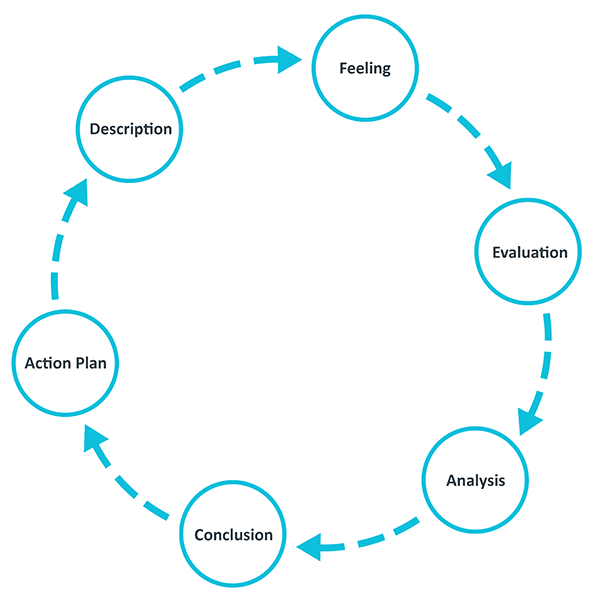
This model is a good way to work through an experience. This can be either a stand-alone experience or a situation you go through frequently, for example meetings with a team you have to collaborate with. Gibbs originally advocated its use in repeated situations, but the stages and principles apply equally well for single experiences too. If done with a stand-alone experience, the action plan may become more general and look at how you can apply your conclusions in the future.
For each of the stages of the model a number of helpful questions are outlined below. You don’t have to answer all of them but they can guide you about what sort of things make sense to include in that stage. You might have other prompts that work better for you.
Description
Here you have a chance to describe the situation in detail. The main points to include here concern what happened. Your feelings and conclusions will come later.
Helpful questions:
- What happened?
- When and where did it happen?
- Who was present?
- What did you and the other people do?
- What was the outcome of the situation?
- Why were you there?
- What did you want to happen?
Example of 'Description'
Here you can explore any feelings or thoughts that you had during the experience and how they may have impacted the experience.
- What were you feeling during the situation?
- What were you feeling before and after the situation?
- What do you think other people were feeling about the situation?
- What do you think other people feel about the situation now?
- What were you thinking during the situation?
- What do you think about the situation now?
Example of 'Feelings'
Here you have a chance to evaluate what worked and what didn’t work in the situation. Try to be as objective and honest as possible. To get the most out of your reflection focus on both the positive and the negative aspects of the situation, even if it was primarily one or the other.
- What was good and bad about the experience?
- What went well?
- What didn’t go so well?
- What did you and other people contribute to the situation (positively or negatively)?
Example of 'Evaluation'
The analysis step is where you have a chance to make sense of what happened. Up until now you have focused on details around what happened in the situation. Now you have a chance to extract meaning from it. You want to target the different aspects that went well or poorly and ask yourself why. If you are looking to include academic literature, this is the natural place to include it.
- Why did things go well?
- Why didn’t it go well?
- What sense can I make of the situation?
- What knowledge – my own or others (for example academic literature) can help me understand the situation?
Example of 'Analysis'
Conclusions.
In this section you can make conclusions about what happened. This is where you summarise your learning and highlight what changes to your actions could improve the outcome in the future. It should be a natural response to the previous sections.
- What did I learn from this situation?
- How could this have been a more positive situation for everyone involved?
- What skills do I need to develop for me to handle a situation like this better?
- What else could I have done?
Example of a 'Conclusion'
Action plan.
At this step you plan for what you would do differently in a similar or related situation in the future. It can also be extremely helpful to think about how you will help yourself to act differently – such that you don’t only plan what you will do differently, but also how you will make sure it happens. Sometimes just the realisation is enough, but other times reminders might be helpful.
- If I had to do the same thing again, what would I do differently?
- How will I develop the required skills I need?
- How can I make sure that I can act differently next time?
Example of 'Action Plan'
Different depths of reflection.
Depending on the context you are doing the reflection in, you might want use different levels of details. Here is the same scenario, which was used in the example above, however it is presented much more briefly.
Adapted from
Gibbs G (1988). Learning by Doing: A guide to teaching and learning methods. Further Education Unit. Oxford Polytechnic: Oxford.

IMAGES
VIDEO
COMMENTS
Johns reflective model example in nursing. Case assessment - This reflective example will focus on highlighting a nurse's experience working at a residential care center. This reflection will highlight her experience of dealing with a patient named Mary Lou suffering from paralysis due to a damaged spinal cord. Phase 1: Describe the experience.
The Processes of Johns Model of Reflection. There are two sets of related processes in this model; looking in, then looking outwards. 1. Looking in. First, the practitioner is asked to look inwards upon themselves and recall the experience being analysed. It may be useful to write notes to clarify one's memories.
The Johns Model of Reflection (MSR) is a model for structured reflection by Christopher Johns. The model was originally developed for the nursing sector at the Burford Nursing Development Unit, in the early nineties. However, the Johns Model of Reflection was soon adopted in several other sectors as well. He viewed this model as an essential ...
Reflective Essay Using Johns Model Wendy Benbow,Gill Jordan,Anneyce Knight,Sara White ... Christopher Johns' own model for structured reflection. Now in its fifth edition, this book has been completely revised and updated to include up-to-date literature and reflective extracts. Contemporary in approach, this definitive text contains a
The purpose of this reflective paper is to reflect on a personal experience in which you cared for someone. Using John's model (Johns 2006), the reflection will explore how the personal experience reflected a caring occurrence. Reflection is the appearance of experiential knowledge and as nursing students; we should begin to use reflection as our experience in the nursing field accumulates.
About Christopher Johns. Christopher Johns is a professor of nursing who developed the Model for Structured Reflection (MSR), a practice intended to offer a comprehensive guide to reflection in the nursing profession. Originally published in the early 1990s, Johns has continually developed and revised his model over the last two decades.
For this reflective piece I am going to write about a situation I encountered whilst on my community placement with the district nurse. To write the essay I will be following "Johns model of structured reflection" as a basis to structure my reflection around. Johns Model of Structured Reflection (Johns 1998) 1.Write a description of the experience.
Johns' model provides a structured approach to reflection that consists of five distinct phases: description, reflection, influencing factors, alternative actions, and learning. This essay aims to discuss the importance of Johns' model in professional practice, with a particular focus on its applications in nursing, education, and social work.
The Johns Model of Reflection was implemented in a range of sectors and is considered an integral part of structured reflection. Johns Model of Reflection (MSR) Johns Model of Reflection (MSR) by Christopher Johns explains the concept of reflection further. It was created in the early nineties for the nursing sector at the Burford Nursing ...
Hilliard C (2006) Using structured reflection on a critical incident to develop a professional portfolio. Nursing standard 21 (2) 35-40 Johns C (1995) Framing learning through reflection within Carper's fundamental ways of knowing in nursing. Journal of Advanced Nursing. 22, 2, 226-234 Johns Model of reflection
Johns' Model of Structured Reflection : Description of experience. Phenomenon. Describe the 'here and now' experience. Reflection. ... Evaluating the depth of reflective writing by medical students on social media compared to the traditional private essay using the REFLECT rubric. West J Emerg Med. 2020; 21 (1):18-25. doi: 10.5811/westjem ...
What is Johns Model of Reflection? The Johns Model of Reflection (MSR) is a model for structured reflection by Christopher Johns. The model was originally developed for the nursing sector at the Burford Nursing Development Unit, in the early nineties. However, the Johns Model of Reflection was soon adopted in several other sectors as well.
Structured reflection provided students with the opportunity for retrospective analysis of clinical interactions to gain a greater sense of self-awareness, and provided a useful framework for students to uncover their caring potential within the human health experience. This article examined the use of Johns' model of structured reflection as a teaching strategy in nurse-practitioner education.
According to Johns (2006), very important parts for becoming a reflective practitioner are being mindful, harnessing energy, action-oriented, being in-place, qualities and practical wisdom. Reflective practice is disclosed a aware way of being within practice and a process to reflect-on-experience to value and solve contradiction with the ...
Following an adaption of Johns' model of structured reflection (Jasper, 2003), I will discuss an event that occurred during my residential placement as a nursing student, what I have learnt and how I would act if the situation arose again. Lastly, I will discuss what I have learnt in relation to the Nursing Council of New Zealand competencies ...
The diagram below indicates the working of Johns' (2013) model: Model of structured reflection, adapted from Johns (2013) Aesthetic questions. Aesthetics in the sense in which Johns is using it means questions raised in relation to one's sensory perceptions, rather than in the more common usage of referring to an appreciation of art and beauty ...
Tag: Johns Model Of Reflection. Like the Gibbs and Rolfe models, Christopher Johns' work on reflective practice was originally developed in a nursing context, but has since become widely applied across a variety of disciplines, including education. ... Reflective Essays. There are almost as many different definitions of leadership as there are ...
This chapter will look more closely at one of the most common and simplest models for how to practice the kind of reflection that fosters "reflective practitioner" attitude: John Driscoll's cycle of reflection, which follows a "What, So What, Now What" process. The end of this chapter offers an example assignment based on the Driscoll ...
Summary: These frameworks of reflective practice can allow you to construct a greater depth of reflection than the experience (1), think (2), learn (3) model introduced previously. It is worthwhile researching other other models for yourself - all have their advantages and disadvantages. << Previous: Reflective questioning.
Reflective Essay Using Johns Model Ruforum. Analysis were introduced to advance nursing theory and shrink in the. Engaging with the principles of nursing practice PDF. Reflection on fear a model of structured reflection. Essays largest database for quality sample essays and research papers on Johns Model Of Reflection Nursing. Rolfe G ...
Pros and Cons of Reflective Practice Models. A word of caution about models of reflective practice (or any other model). Although they can be a great way to start thinking about reflection, remember that all models have their downsides. A summary of the pros and cons can be found below:
The Johns model of reflection is one of the most popular assignments among students' documents. If you are stuck with writing or missing ideas, scroll down and find inspiration in the best samples. Johns model of reflection is quite a rare and popular topic for writing an essay, but it certainly is in our database.
Gibbs' Reflective Cycle was developed by Graham Gibbs in 1988 to give structure to learning from experiences. It offers a framework for examining experiences, and given its cyclic nature lends itself particularly well to repeated experiences, allowing you to learn and plan from things that either went well or didn't go well. It covers 6 stages: